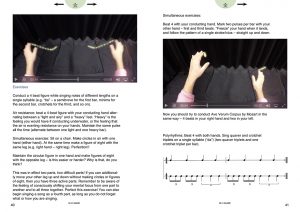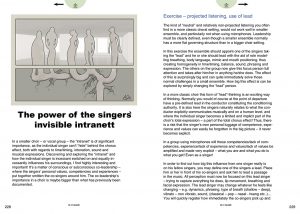Book Review: The Learning Conductor
Reviewed by Tobin Sparfeld, DMA, teacher and conductor
Author Thomas Caplin is a professor and choral director in Norway. He currently conducts the Defrost Youth Choir, Lund Academic Male Choir, and is a professor in Choral Conducting and Management at the Inland Norway University of Applied Sciences. In his book, The Learning Conductor, Caplin addresses many of the main aspects regarding the leadership of a choral ensemble. While he admits it is far from a complete examination of the subject, it is a broad introduction to many concepts of choral conducting.
The Learning Conductor was first published in 1995 and has been revised several times. This e-book is the first edition in English and was published in 2015. The book has three main sections; the first deals with the mechanics of conducting techniques, the second covers the psychology and leadership skills necessary and the third examines aspects of choral methods.
The section on conducting mechanics is the strongest section. Caplin begins by describing the ideal hand position with open space between the fingers. From there, he introduces the four main beat patterns. While some conducting textbooks begin with duple metre, Caplin starts with the one-beat pattern, describing the sensation as if bouncing a ball on the ground. Several musical examples are included along with written descriptions about specific feelings and characteristics. The text discusses four different dimensions experienced while conducting—gravity, time/timing, ‘flow’ (horizontal motion of the beat pattern), and space. A mantra repeated throughout the text is: “What you do is what you get!”, a phrase similar to Rod Eichenberger’s “What they see is what you get.”
Beats are added to each gesture to create duple, triple, and quadruple meter patterns. Five and six-beat patterns are introduced, while larger compound metres and subdivisions are briefly mentioned. Illustrations and videos are provided in the e-book.
Caplin then reviews preparatory beats, cut-offs/releases, and the various ways to conduct fermatas (with/without cut-offs, pauses, etc.). While these are touched on, novice conductors may have difficulty learning how to conduct these more advanced gestures from the book alone. The section concludes analysing the causes of a common malady he refers to as “jigging,” where the conductor jerks away from the beat instead of down into the ictus (as if touching a hot stove for each beat).
The second section begins on page 135 and focuses on the psychology of choral conductors and singers. Caplin believes that conductors should empower singers and give them greater responsibility by delegating some of the conductor’s roles to the singers, the choir’s board (if one exists), and by having conversations with the singers about group goals and objectives. Caplin writes that “[m]usic is all about humanity—where the conductor learns to lead the whole person behind the voice.“ The following chapters on the Learning Choir, written by Stig Eriksen, consider the mental aspects of conducting, including the importance of kinaesthetic learning, gesture, and overall mindfulness in teaching. While containing well-researched information, it concludes without providing much applicable benefit to the choral conductor.
The third section contains elements traditionally grouped together as choral methods. The rehearsal methodology chapter gives basic tips on how to structure a rehearsal and how to rehearse individual parts while engaging the other singers. Piano playing of vocal parts is given significant attention, as well as warm-ups (though there are no specific warm-ups provided) and the use of amplified sound. Caplin makes a good distinction that when singing with a microphone, singers must learn to focus their auditory perception towards the sound coming out of the loudspeaker, not their own immediate sound.
The textbook also briefly comments on the appreciation of music, fidelity to the score, a brief look at some of the modern techniques of contemporary choral music, and a sizeable section on the arrangement of sections within the choral ensemble. The closing chapters address the perception of choral sound, the importance of partnership in choral music (written by Peder Karlsson), choral intonation, and Latin pronunciation.
At nearly 320 pages, The Learning Conductor is not a short book. However, because it tackles so many topics in a brief fashion, it feels much shorter. The writing is concise and clear, which is especially important when describing the motions and sensations of conducting. However, there could be more illustrations of correct posture and movement for conductors and the beat pattern illustrations are more angular than most choral conductors would typically employ. Several subjects are lacking, including score study, repertoire selection, rehearsal pedagogy, diction and the more advanced conducting gesture areas that include prep beats and subdivisions. Also, there is nothing regarding vocal pedagogy or any details regarding the voice.
The Learning Conductor is ideally suited to beginning choral conductors or those with limited experience, especially those who are already singers (and who have previous knowledge of vocal training). With its discussion of piano playing and microphone use and less attention given to score study/repertoire, the book is also more geared towards community choirs rather than academic or church choir settings. Caplin encourages more experienced conductors to begin at the end of the book and work their way to the start, thus getting to the most original sections first. While it can function as a choral conducting textbook for an overview academic course, institutions that divide the conducting and choral methods components will most likely prefer books which are more thorough, regarding either area. The Learning Conductor lacks a “textbook feel” due to it not containing exercises, review questions, and fewer illustrations.
Caplin draws on his experience to share his best insights with readers, and uses his words efficiently. While there are many books on conducting gesture out there, this is currently one of the few e-books on choral conducting, making it an attractive digital resource for modern conductors. While not complete, this broad overview of conducting is one that is worthy to be considered.
 As a former member of the St. Louis Children’s Choirs, Tobin Sparfeld has toured over the world, from as far west as Vancouver, British Columbia, to as far east as Moscow, Russia. Tobin has also sung with Seraphic Fire and the Santa Fe Desert Chorale. Tobin has worked with choirs of all ages, serving as Assistant Music Director of the Miami Children’s Chorus as well as the Associate Director of the St. Louis Children’s Choirs. He also taught at Principia College and was the Director of Choral Activities at Millersville University of Pennsylvania. Tobin received a DMA in Conducting from the University of Miami in Coral Gables, studying with Jo-Michael Scheibe and Joshua Habermann. He also received an Artist Teacher Diploma from the CME Institute led by Doreen Rao. He currently directs two choirs and the vocal program at Glendale Community College in Glendale, California. Email: tobin.sparfeld@gmail.com
As a former member of the St. Louis Children’s Choirs, Tobin Sparfeld has toured over the world, from as far west as Vancouver, British Columbia, to as far east as Moscow, Russia. Tobin has also sung with Seraphic Fire and the Santa Fe Desert Chorale. Tobin has worked with choirs of all ages, serving as Assistant Music Director of the Miami Children’s Chorus as well as the Associate Director of the St. Louis Children’s Choirs. He also taught at Principia College and was the Director of Choral Activities at Millersville University of Pennsylvania. Tobin received a DMA in Conducting from the University of Miami in Coral Gables, studying with Jo-Michael Scheibe and Joshua Habermann. He also received an Artist Teacher Diploma from the CME Institute led by Doreen Rao. He currently directs two choirs and the vocal program at Glendale Community College in Glendale, California. Email: tobin.sparfeld@gmail.com
Edited by Rebeka Angstamann, UK



